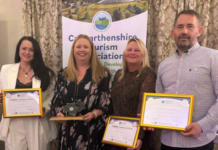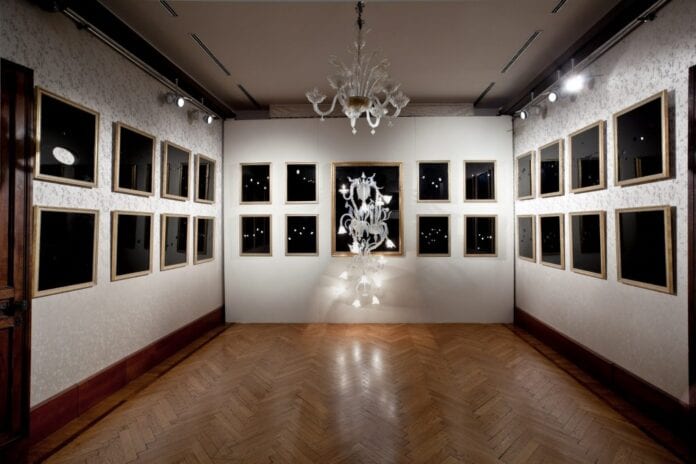Some of the world’s leading contemporary artists are invited to breathe new life into centuries-old glass-making in Venice ―
|
Watch the new video at youtu.be/LSztp-DAODE |
|
Among the 34 artists: Ai Weiwei, Fred Wilson, Joyce J. Scott, Jimmie Durham, Ugo Rondinone, Fiona Banner, Vik Muniz, Monica Bonvicini, Jake & Dinos Chapman, Laure Prouvost, Renate Bertlmann, Thomas Schütte, Loris Gréaud, and Erwin Wurm |
|
|
Above: Ai Weiwei with his massive glass-blown sculpture “Blossom Chandelier,” in Venice. The large-scale installation bursts with unexpected shapes emanating from white glass flowers to surprise the eye: menacing handcuffs, twitter birds, security cameras, and the artist’s own hands flashing his middle finger (his angry response to the Chinese government that imprisoned him). Photo by Karolina Sobel. |
|
|
|
From Venice to Boca Raton for the 2021 U.S. Premiere of Glasstress |
|
|
|
Most of these art stars have represented their countries at the Venice Biennale |
|
Watch the new video at youtu.be/LSztp-DAODE |
|
|
|
“There is every reason this year to have a world view,” says Irvin Lippman, the Boca Raton Museum of Art‘s Executive Director, as South Florida boldly ushers in the new year with the national premiere of Glasstress 2021 Boca Raton. |
|
“Three years in the making, with 2020 being such a challenging year to coordinate an international exhibition of this size and scope, the effort serves as an important reassurance that art is an essential and enduring part of humanity.” |
|
“This is also a tribute to the resilience of Venice’s surviving the floods and continuing to make art through the pandemic,” adds Irvin Lippman. |
|
Most of these works in glass have never been seen elsewhere, and were handpicked by Kathleen Goncharov, the Museum’s Senior Curator who traveled to Italy in 2019. |
|
|
Rosemarie’s Divorce, Renate Bertlmann (2019). Glass, pedestal, scalpels, and steel. |
|
|
|
Glasstress 2021 Boca Raton On view now through September 5th at the Boca Raton Museum of Art |
|
|
|
Some of the world’s leading contemporary artists are invited to breathe new life into centuries-old glassmaking in Venice ― maestros of glassblowing from the legendary Berengo Studio residency help artists manifest their visions |
|
|
|
Among the 34 artists: Ai Weiwei, Fred Wilson, Joyce J. Scott, Jimmie Durham, Ugo Rondinone, Fiona Banner, Vik Muniz, Monica Bonvicini, Jake & Dinos Chapman, Laure Prouvost, Renate Bertlmann, Thomas Schütte, Loris Gréaud, and Erwin Wurm |
|
|
|
|
Detail of Strike Twice, Jimmie Durham (2019). Glass and metal. |
|
The new exhibition runs January 27 through September 5, 2021 and the Museum will feature online initiatives for virtual viewing. Watch the video here featuring interviews with some of the artists in the new exhibition. |
|
The 34 artists in this new, never before seen edition of Glasstress were all invited by Adriano Berengo to work alongside his master glass artisans at the Berengo Studio on the island of Murano in the Venetian lagoon. |
|
Watch the new video at youtu.be/LSztp-DAODE |
|
With incredible energy, the Studio has brought a new vision on how to stimulate today’s leading artists into thinking how the medium of glass can be made into dramatic and provocative works of contemporary art. |
|
Most of these artists have, during their careers, been invited to participate in the Venice Biennale. |
|
Some of the works were created during the pandemic lockdowns, with artists collaborating remotely via Zoom with their glass artisan partners after initial on-site work at the studio in Venice. |
|
|
|
“Unlike the past and the present, what comes next for our world presents itself as constant possibility, always transforming as we move forward in time,” says Adriano Berengo. “This concept of transformation has always held an affinity with glass, a medium which – as the name Glasstress suggests – exists in a state of constant tension. Life needs tension, it needs energy, and a vibrant exchange of ideas.” |
|
|
|
|
an ocean away, Ugo Rondinone (2017). Glass. |
|
The exhibition presents 34 new works that explore some of today’s pressing subjects, including human rights, climate change, racial justice, gender issues and politics. The Boca Raton Museum of Art has dedicated more than 6,500 square feet of exhibition space to this collection. A fully illustrated catalogue is also available. |
|
|
Ai Weiwei at the Berengo studio in Venice, next to his glass sculpture Blossom Chandelier. The large-scale installation bursts with unexpected shapes emanating from white glass flowers to surprise the eye: menacing handcuffs, twitter birds, security cameras, and the artist’s hands flashing his middle finger (the latter is his angry response to the Chinese government that imprisoned him). Photo by Karolina Sobel. |
|
Watch the new video at youtu.be/LSztp-DAODE |
|
|
|
|
Time, Penzo + Fiore, an artistic duo who live and work in Venice (2018). Video, color, sound. |
|
The mission of Glasstress is to restore the visibility and reputation of Murano glass, after decades of closures of ancient, centuries-old glass furnaces. Instead of creating decorative objects with glass, these artists are invited to create original works, often on a massive scale. |
|
They collaborate with glass masters whose expertise has been developed over generations in Venice. Most of these artists have never worked with glass, so they unite their artistic ideas with the technical expertise of their skilled collaborators. The results are breathtaking. |
|
|
|
The first installation visitors to the Museum will encounter is Sala Longhi by Fred Wilson (pictured below). He created this series at Berengo Studio after the Biennale exhibited his work about Black residents of Venice from the Renaissance to the present. |
|
|
Sala Longhi, Fred Wilson (2011). Glass and wood. |
|
This installation features an ornate white chandelier with 29 glass panels that mirror 18th-century Venetian artist Pietro Longhi’s paintings. Instead of canvases, Wilson shows the viewer only the whites of the eyes of his Black subjects through cutouts in black reflective glass. |
|
|
Details of Sala Longhi, Fred Wilson (2011). Glass and wood. |
|
View stunning images from cities around the world that have hosted previous Glasstress exhibitions at this link: glasstress.org/my-product_category/glasstress-world.
|
|
“We have brought Glasstress to countries around the world for ten years, seeking to expand and enliven international awareness of the variety and richness of contemporary artists using glass in their creative practices,” adds Adriano Berengo. |
|
“In the past, its place in the art world might have seemed uncertain. But now in this latest edition of Glasstress, the first after a global pandemic, one thing we know for certain: glass endures. Life is fragile, just as glass is fragile, yet in this fragility there is also strength.” |
|
“It is in this spirit of experimentation that Glasstress Boca Raton 2021 explores the limitless potential of glassblowing. “We realize how far we have come as we approach the 60th anniversary of the American studio glass movement that launched in 1962 through the efforts of Harvey Littleton and Dominick Labino,” adds Irvin Lippman. “This presentation of Glasstress is also a tribute to them.” |
|
|
Detail of Glass Big Brother, Song Dong (2015). Glass and metal. |
|
This show also unveils the Museum’s new acquisition for its collection, created in the Berengo Studio – Glass Big Brother, a sculpture by Song Dong, one of contemporary Chinese art’s leading figures. The large-scale installation is 11 feet long and reaches all the way to the floor. Thirty surveillance cameras are ensconced from top to bottom, looking in all directions around. |
|
“Certainly, this chandelier sculpture by Song Dong with its glass-blown surveillance cameras, is both poetic and poignant,” says Irvin Lippman. “It was commissioned by the Museum to hang in our new Wolgin Education Center front windows that face pedestrians walking across Mizner Park.”
|
|
|
The Container of Thinking, Yin Xiuzhen (2015). Glass. |
|
|
|
The installation Rosemarie’s Divorce, by Renate Bertlmann, unites aspects from Rosemarie’s Baby (1983), her multi-part installation about the ambivalent relationship between mother and child, and Discordo Ergo Sum, a field of knife-roses she exhibited at the Venice Biennale in 2019. |
|
The monstrously enlarged glass pacifier is an image she has used since the mid-1970s referencing sexuality and motherhood. It is flanked by two knife-roses made of deep black glass. |
|
|
Detail of Rosemarie’s Divorce, Renate Bertlmann (2019). Glass, pedestal, scalpels, and steel. |
|
|
|
The work of Italian artist Monica Bonvicini (below), features deeply psychological themes that address sexuality, power, and relationships in male-oriented domains. |
|
|
The Glasstress furnace in Venice blazes behind the artist Monica Bonvicini as she works on her glass sculpture Bonded. |
|
Bonvicini’s visits to sadomasochist nightclubs with Gay male friends are the inspiration for Bonded. She won the prestigious Golden Lion award at the 1999 Venice Biennale. |
|
|
Bonded, Monica Bonvicini (2017). Glass and metal. |
|
|
|
|
DNA HAS NO COLOR, Nancy Burson (2019). Glass. |
|
DNA HAS NO COLOR is a new statement from Nancy Burson that is a powerful work about the illegitimacy of racism. |
|
This is a continuation of the project that Zaha Hadid commissioned Burson to develop for the London Millennium Dome. |
|
Burson is known for biology-related work, including her use of cutting edge facial morphing technology for art that shows what individuals would look like as a different race. |
|
|
|
|
The Pandemic Oculus, Tim Tate (2020), Glass. |
|
The Pandemic Oculus, (2020), by Tim Tate, whose work explores the worlds of loss, memory, recovery, and hope. |
|
As an HIV-positive man, he lived through the worst of the AIDS epidemic during the 1980s and 1990s, and now through the current pandemic. |
|
In the Museum’s exhibition catalogue, the artist states that Pandemic Oculus also honors the many unsung heroes around the world: nurses, teachers, essential employees, grandparents caring for children so that parents can work, and so many more. |
|
Tate is the co-founder of the Washington Glass Studio in Washington, DC. He is also the co-moderator, along with William Warmus, of the 21st Century Glass group on Facebook, which has shared and discussed over 10,000 images of sculptural glass from around the world. |
|
|
Mutter, Erwin Wurm (2018), Glass. |
|
Erwin Wurm’s wry sense of humor permeates his most famous works and has served him well in creating a poignant cultural commentary throughout his career. |
|
Wurm produced this triad in cold hard glass at the Berengo Studio. They are smaller versions of the massive bronze sculpture of a hot water bottle with legs, Big Mutter, that he created for the Venice Biennale in 2020. |
|
In the exhibition catalogue, the show’s curator Kathleen Goncharov describes these “mothers” as neither warm nor comforting . . . their stubby little legs imply flight when called upon to be caregivers. |
|
|
Strike Twice, Jimmie Durham (2019). Glass and metal. |
|
At the Berengo Studio, Jimmie Durham created a series of eight giant cougar heads suspended on metal armatures. Caught in suspension as they gaze at one another, their collective roar remains frozen between them. |
|
The cougar is one of the most sacred animals in Cherokee mythology, and the influence of Native-American culture vs. Western rationalism is evident in his work. |
|
The artist’s long trajectory includes his work during the civil rights movement and as a political organizer for the American Indian Movement. In 2019, Durham was the recipient of the Golden Lion for Lifetime Achievement award at the 58th Venice Biennale. |
|
|
Prune Nourry at the Berengo Studio in Venice. |
|
In the Museum’s exhibition catalogue, curator Kathleen Goncharov describes Prune Nourry as no stranger to illness . . . her work always dealing with science and bioethics from a feminist perspective, a focus that has intensified since her breast cancer diagnosis in 2018. |
|
At the Berengo Studio, she created River Woman, a transparent skeletal sculpture based on an anatomical drawing of the human vascular system. |
|
While its form may be human, the arteries resemble rivers, streams and trees that suffer in their own way too, from human abuse rather than disease. |
|
|
River Woman, Prune Nourry (2019). Borosilicate glass. |
|
Ugo Rondinone represented his home country in the Swiss Pavilion at the 52nd Venice Biennale (2007). |
|
In this work, the twelve glass horses cast in beautiful shades of blue all face different directions, creating delicate light games with their reflections and shadows in continuous motion. |
|
|
Detail of an ocean away, Ugo Rondinone (2017). Glass. |
|
In the context of this installation, the reappearing motif of a horse (which has a long tradition in the history of art), evokes alienation and a subversive twist emblematic of Rondinone’s works. |
|
While its form may be human, the arteries resemble rivers, streams and trees that suffer in their own way too, from human abuse rather than disease. |
|
|
From left to right – Palimpsest (Made in Italy), Andrew Huston (2020). Cast glass. Fire, Federica Marangoni (2008-2012). Glass wheels and neon coil. |
|
Download photos at this link: https://spaces.hightail.com/space/hxjnGnWNdJ |
|
For media interviews and more info contact: Jose Lima & Bill Spring editorial@newstravelsfast.com 305-910-7762 |
|
|
|
Note to Editors: The Museum is also debuting two other original exhibitions opening on January 27, An Irresistible Urge to Create: The Monroe Family Collection of Florida Outsider Art (on view through Sept. 5), and Paul Gervais: Faces and Forms (on view through May 30). Editorial information for the press and images of artworks are available by contacting editorial@newstravelsfast.com. |
|
|
Help keep news FREE for our readers
Supporting your local community newspaper/online news outlet is crucial now more than ever. If you believe in independent journalism, then consider making a valuable contribution by making a one-time or monthly donation. We operate in rural areas where providing unbiased news can be challenging. Read More About Supporting The West Wales Chronicle

























































